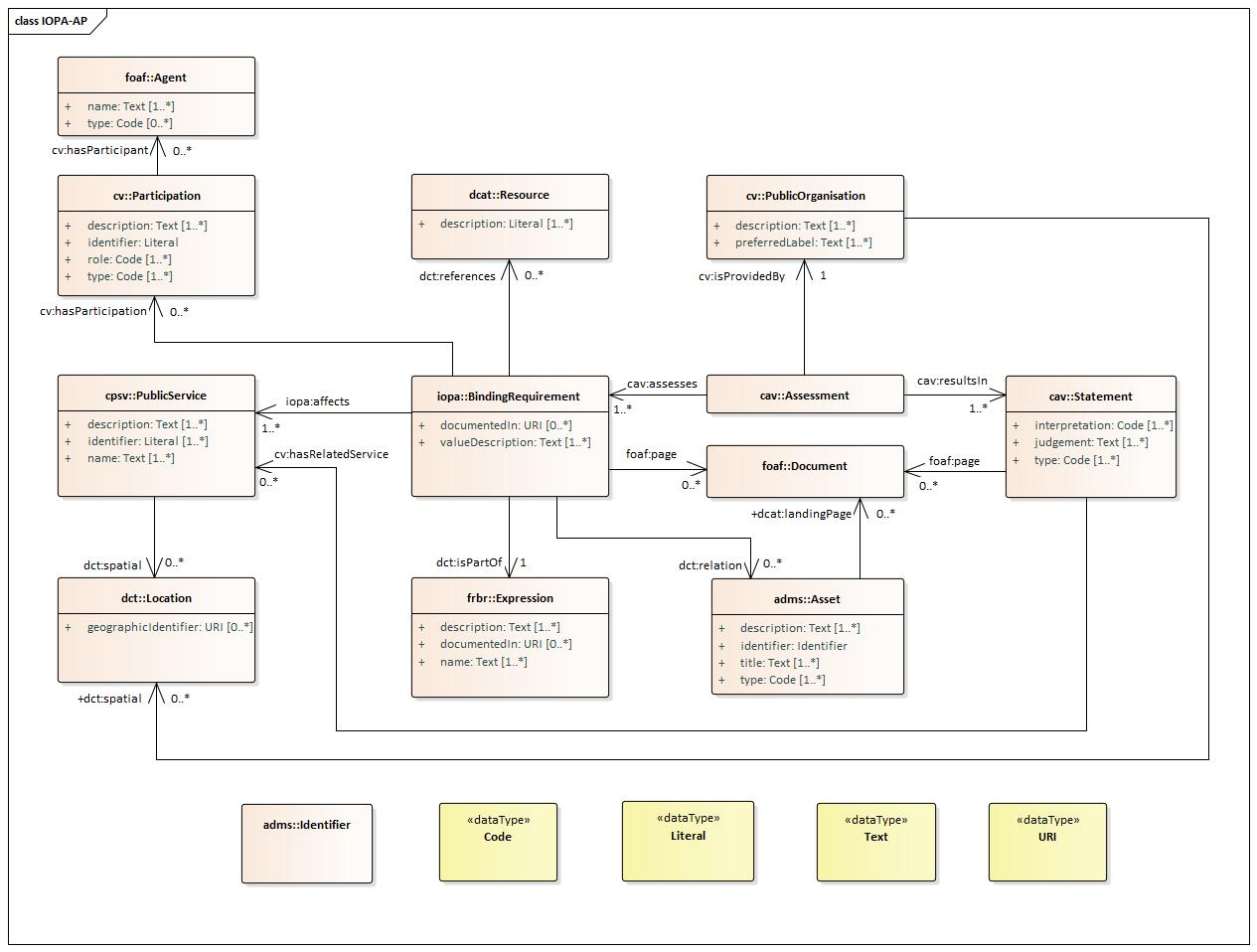| Agent |
http://xmlns.com/foaf/0.1/Agent |
Mandatory |
name |
http://purl.org/dc/terms/title |
| Agent |
http://xmlns.com/foaf/0.1/Agent |
Optional |
type |
http://purl.org/dc/terms/type |
| Assessment |
http://data.europa.eu/2sa/cav#Assessment |
Mandatory |
assesses |
http://data.europa.eu/2sa/cav#assesses |
| Assessment |
http://data.europa.eu/2sa/cav#Assessment |
Mandatory |
is provided by |
http://data.europa.eu/m8g/isProvidedBy |
| Assessment |
http://data.europa.eu/2sa/cav#Assessment |
Mandatory |
results in |
http://data.europa.eu/2sa/cav#resultsIn |
| Asset |
http://www.w3.org/ns/adms#Asset |
Mandatory |
description |
http://purl.org/dc/terms/description |
| Asset |
http://www.w3.org/ns/adms#Asset |
Mandatory |
identifier |
http://www.w3.org/ns/adms#identifier |
| Asset |
http://www.w3.org/ns/adms#Asset |
Mandatory |
title |
http://purl.org/dc/terms/title |
| Asset |
http://www.w3.org/ns/adms#Asset |
Mandatory |
type |
http://purl.org/dc/terms/type |
| Asset |
http://www.w3.org/ns/adms#Asset |
Optional |
landing page |
http://www.w3.org/ns/dcat#landingPage |
| Binding Requirement |
http://data.europa.eu/2qy/iopa#BindingRequirement |
Mandatory |
affects |
http://data.europa.eu/2qy/iopa#affects |
| Binding Requirement |
http://data.europa.eu/2qy/iopa#BindingRequirement |
Mandatory |
is part of |
http://purl.org/dc/terms/isPartOf |
| Binding Requirement |
http://data.europa.eu/2qy/iopa#BindingRequirement |
Mandatory |
value description |
http://data.europa.eu/2sa/cav#valueDescription |
| Binding Requirement |
http://data.europa.eu/2qy/iopa#BindingRequirement |
Optional |
documented in |
http://data.europa.eu/2sa/cav#documentedIn |
| Binding Requirement |
http://data.europa.eu/2qy/iopa#BindingRequirement |
Optional |
has participation |
http://data.europa.eu/m8g/hasParticipation |
| Binding Requirement |
http://data.europa.eu/2qy/iopa#BindingRequirement |
Optional |
page |
http://xmlns.com/foaf/0.1/page |
| Binding Requirement |
http://data.europa.eu/2qy/iopa#BindingRequirement |
Optional |
references |
http://purl.org/dc/terms/references |
| Binding Requirement |
http://data.europa.eu/2qy/iopa#BindingRequirement |
Optional |
relation |
http://purl.org/dc/terms/relation |
| Document |
http://xmlns.com/foaf/0.1/Document |
|
|
|
| Expression |
http://purl.org/vocab/frbr/core#Expression |
Mandatory |
description |
http://purl.org/dc/terms/description |
| Expression |
http://purl.org/vocab/frbr/core#Expression |
Mandatory |
name |
http://purl.org/dc/terms/title |
| Expression |
http://purl.org/vocab/frbr/core#Expression |
Optional |
documented in |
http://data.europa.eu/2sa/cav#documentedIn |
| Identifier |
http://www.w3.org/ns/adms#Identifier |
|
|
|
| Location |
http://purl.org/dc/terms/Location |
Optional |
geographic identifier |
http://www.w3.org/2000/01/rdf-schema#seeAlso |
| Participation |
http://data.europa.eu/m8g/Participation |
Mandatory |
description |
http://purl.org/dc/terms/description |
| Participation |
http://data.europa.eu/m8g/Participation |
Mandatory |
identifier |
http://purl.org/dc/terms/identifier |
| Participation |
http://data.europa.eu/m8g/Participation |
Mandatory |
role |
http://data.europa.eu/m8g/role |
| Participation |
http://data.europa.eu/m8g/Participation |
Mandatory |
type |
http://purl.org/dc/terms/type |
| Participation |
http://data.europa.eu/m8g/Participation |
Optional |
has participation |
http://data.europa.eu/m8g/hasParticipant |
| Public Organisation |
http://data.europa.eu/m8g/PublicOrganisation |
Mandatory |
description |
http://purl.org/dc/terms/description |
| Public Organisation |
http://data.europa.eu/m8g/PublicOrganisation |
Mandatory |
preferred label |
http://www.w3.org/2004/02/skos/core#prefLabel |
| Public Organisation |
http://data.europa.eu/m8g/PublicOrganisation |
Optional |
spatial |
http://purl.org/dc/terms/spatial |
| Public Service |
http://purl.org/vocab/cpsv#PublicService |
Mandatory |
description |
http://purl.org/dc/terms/description |
| Public Service |
http://purl.org/vocab/cpsv#PublicService |
Mandatory |
identifier |
http://purl.org/dc/terms/identifier |
| Public Service |
http://purl.org/vocab/cpsv#PublicService |
Mandatory |
name |
http://purl.org/dc/terms/title |
| Public Service |
http://purl.org/vocab/cpsv#PublicService |
Optional |
spatial |
http://purl.org/dc/terms/spatial |
| Resource |
http://www.w3.org/ns/dcat#Resource |
Mandatory |
description |
http://purl.org/dc/terms/description |
| Statement |
http://data.europa.eu/2sa/cav#Statement |
Mandatory |
interpretation |
http://data.europa.eu/2sa/cav#interpretation |
| Statement |
http://data.europa.eu/2sa/cav#Statement |
Mandatory |
judgement |
http://data.europa.eu/2sa/cav#judgement |
| Statement |
http://data.europa.eu/2sa/cav#Statement |
Mandatory |
type |
http://data.europa.eu/2sa/cav#type |
| Statement |
http://data.europa.eu/2sa/cav#Statement |
Optional |
has related service |
http://data.europa.eu/m8g/hasRelatedService |
| Statement |
http://data.europa.eu/2sa/cav#Statement |
Optional |
page |
http://xmlns.com/foaf/0.1/page |

![[o]](html/callout.png)